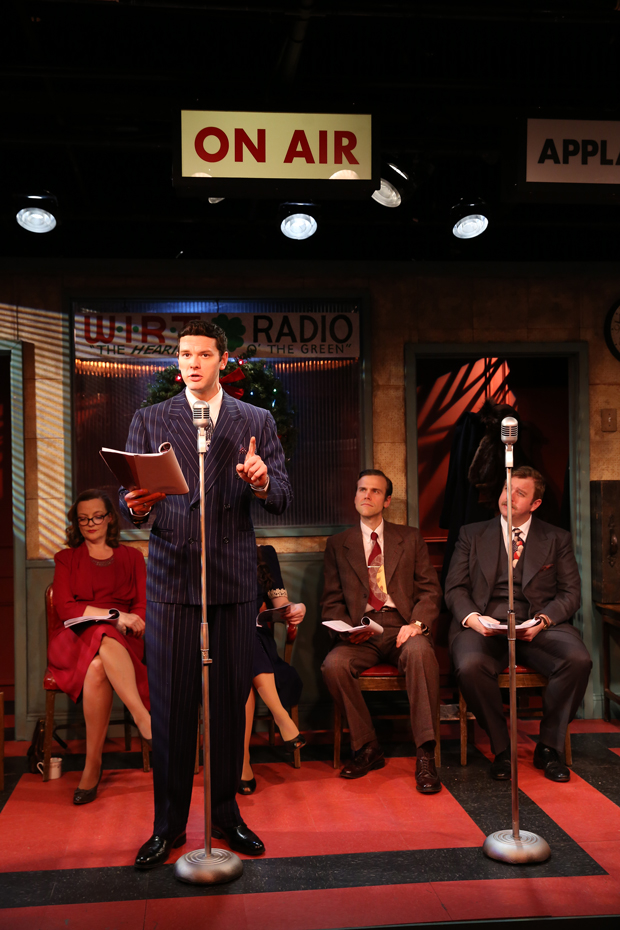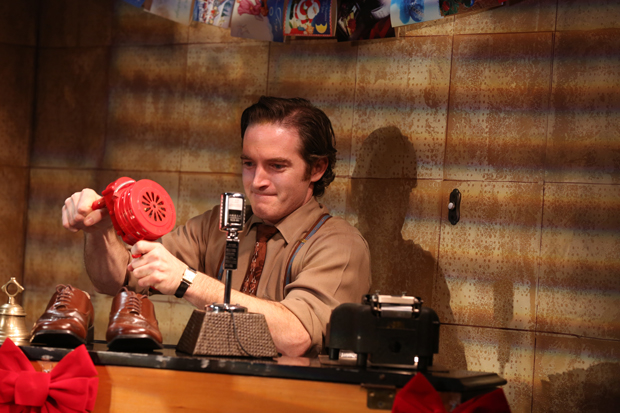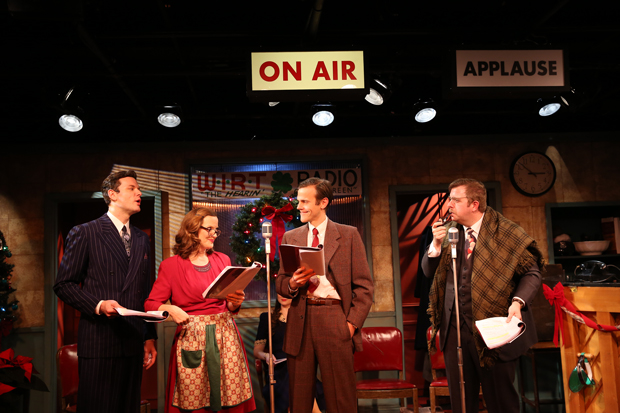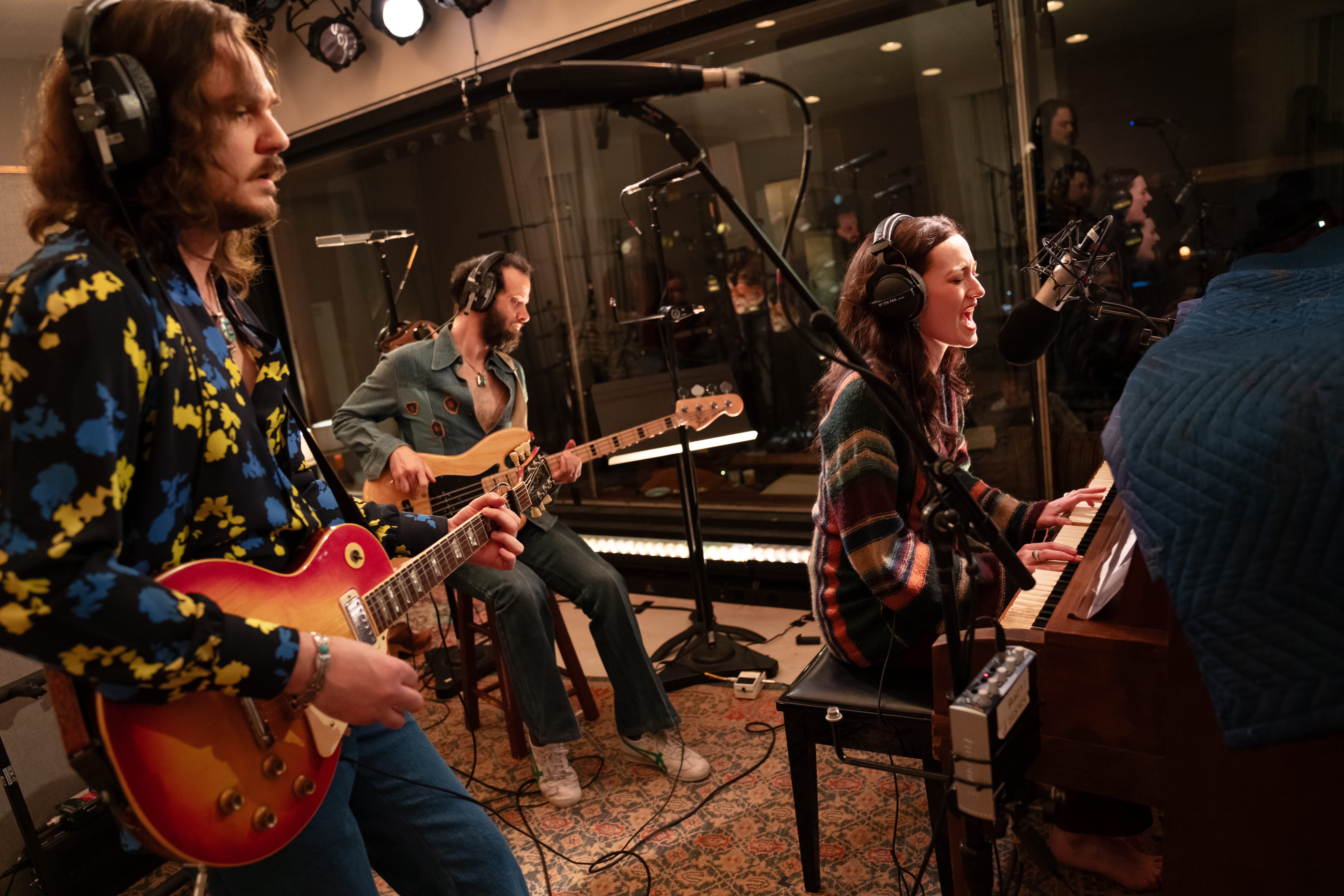It's a Wonderful Life: The 1946 Live Radio Play

(© Carol Rosegg)
If you know the film It's a Wonderful Life, then there aren't many surprises in store for you with Anthony Palermo's radio play adaptation, getting a third outing at the Irish Repertory Theatre after runs during the 2012 and 2013 holiday seasons. It's a Wonderful Life: The 1946 Live Radio Play sticks faithfully to the plot of Frank Capra's 1946 classic, with the exception of a few compressions to keep the show to a lean 70 minutes. This version doesn’t diverge from or reinterpret its widely beloved source material. Rather, it feels cozy in its predictability, a feeling bolstered by James Morgan's sound-studio set design, with bright-red ornaments and pastel yellow walls giving the stage a rosy old-time glow.
Paradoxically, though, this production also feels positively experimental in our technologically inundated modern times. Palermo has devoted his professional career to the possibilities of sonic artistry, and so it's no surprise that it's the SFX artist, Rory Duffy, who emerges as the real star of this show. Even as most of us can see the plot turns coming a mile away, Duffy offers the most consistent delights with his props and gadgets for creating the sounds of footfalls, car horns, and slamming doors, all of which we see him produce right in front of us. If anything, the story acts as a clothesline for Duffy's sound effects, an impression that speaks to the larger aim of It's a Wonderful Life: The 1946 Live Radio Play: to remind us of a time when we didn't necessarily take images for granted, when artists were sometimes forced to conjure up entire worlds wholly through the medium of sound.

(© Carol Rosegg)
Palermo clearly sees this pre-digital era with affection, as evidenced in its prologue, with all six performers — Aaron Gaines, Haley Bond, Dewey Caddell, Ian Holcomb, Orlagh Cassidy, and Duffy — entering the W. Scott McLucas Studio Theatre, walking onto the stage one by one, and warmly interacting with one another as if this was just another day at the office. (Amusingly, Cassidy, arguably the best-known of the cast members, is characterized as the prototypical habitually late diva who brags about being at the opening of Brigadoon the night before and who is too scattered to have remembered to bring her script along.) And in between acts (the show is divided into three segments), director Charlotte Moore has included parodies of ads for once-popular brands such as Lucky Strike cigarettes, with the spots referencing classic Hollywood stars like John Wayne and Humphrey Bogart. Costume designer Barbara Bell has clothed the actors in conservative period-appropriate attire that adds to the homely feel.
Nostalgia is embedded into every aspect of It's a Wonderful Life: The 1946 Live Radio Play — perhaps to a fault. One might wish for a harder edge to some of the performances; as main character George Bailey, the all-American boy who finds his grand dreams of fleeing Bedford Falls and seeing the world gradually ground down by the difficulties of both married life and maintaining his family's banking business, Aaron Gaines may at times skillfully evoke James Stewart's distinct vocal cadences, but is less effective at conveying the character's mounting desperation, one that takes him to the edge of suicide. For all its reputation as a piece of sentimental uplift, Frank Capra's It's a Wonderful Life has a dark side — an ambivalent-verging-on-bitter view of small-town American life — that this production only grazes. Only Dewey Caddell brings any palpable sense of menace to this production whenever he takes up the role of Bailey's primary nemesis, the manipulative and megalomaniacal Mr. Potter (Caddell also voices Clarence, the angel who will lead the way for Bailey's salvation).
But to hanker for a more emotionally wide-ranging experience is to wish for something fundamentally different from what Palermo and Moore are interested in providing. It's a Wonderful Life: The 1946 Live Radio Play is comfort food par excellence, with the cast and crew invested less in replacing our fond memories of Capra's film than in allowing us to experience this time-honored story in a way that feels both retroactively fresh and snugly old-fashioned. There's nothing wrong with indulging, especially under hands as capable and affectionate as these.

(© Carol Rosegg)










